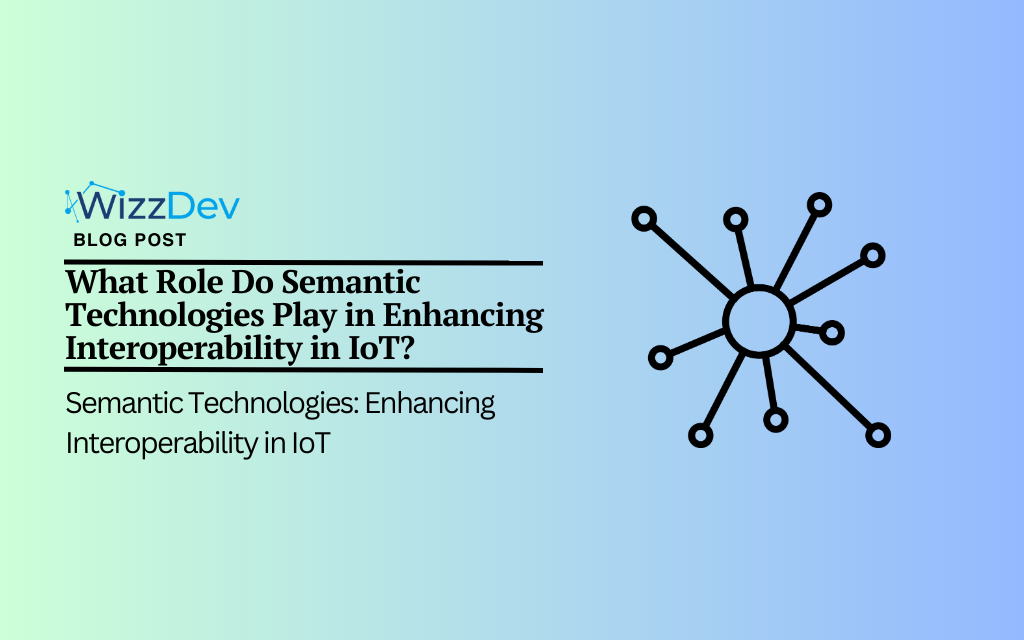The Internet of Things (IoT) is a field that is quickly expanding. It involves connecting various devices and systems to collect and exchange data. As the number of connected devices increases, it becomes increasingly important for these devices to work together seamlessly. This is known as interoperability, and it refers to the ability of different systems and devices to communicate with each other.
One way to enhance interoperability in IoT systems is through the use of semantic technologies. Semantic technologies provide a way to represent and organize data in a way that makes it easier for machines to understand and process. By using semantic technologies, it is possible to improve interoperability between different IoT devices and systems.
In this blog post, we will explore the challenges of achieving interoperability in IoT systems and how semantic technologies can help to overcome these challenges. We will also look at real-world examples and use cases where semantic technologies have been used to enhance interoperability in IoT systems.
The Challenge of Interoperability in IoT
Interoperability between IoT systems isn’t always easy to achieve. It is becoming increasingly important for all of these interconnected devices to be able to talk to one another and coordinate their efforts.
Lack of standardization is a major barrier to interoperability in IoT systems. There is often a lack of common standards and protocols for communication due to an increasing number of devices and systems developed by different manufacturers. This can hamper the ability of various gadgets to interact with one another. Another challenge in IoT is the complexity of the systems themselves. With so many different devices and systems involved, it can be difficult to ensure that all components are able to communicate and work together effectively. Achieving this requires significant effort and expertise.
Interoperability is essential for the success and growth of IoT systems, despite the challenges it presents. By improving interoperability, the full potential of IoT systems can be unlocked, enabling new and innovative applications.
Semantic Technologies and their Role in IoT
Data can be represented and organized with the help of semantic technologies, making it more accessible to machines. Semantic technologies allow for greater device and system interoperability in the IoT. One of the main advantages of incorporating semantic technologies into IoT systems is that they offer a shared language for data representation. This simplifies communication and data exchange among different devices and systems, even if they use distinct communication protocols and were created by various manufacturers.
Integrating data from multiple sources is simplified by semantic technologies as well. Data from disparate sources can be usefully combined with the help of standardized data models and ontologies. This has the potential to enhance the performance and utility of IoT systems as a whole.
In summary, semantic technologies can play an important role in enhancing interoperability in IoT systems. By providing a common language for representing data and making it easier to integrate data from different sources, semantic technologies can help to overcome some of the challenges of achieving interoperability in IoT systems.
Use Cases and Examples
There are many real-world examples and use cases where semantic technologies have been used to enhance interoperability in IoT systems. Here are a few examples:
- Healthcare: IoT devices are increasingly being used in healthcare to monitor patient health and improve patient outcomes. By using semantic technologies, it is possible to improve the interoperability between different healthcare devices and systems, allowing doctors and healthcare providers to access and share patient data more easily.
- Transportation: The transportation industry is another area where IoT devices are being used to improve efficiency and safety. By using semantic technologies, it is possible to improve the interoperability between different transportation systems, allowing for better coordination and communication between vehicles, infrastructure, and transportation management systems.
- Smart Cities: Smart cities are using IoT devices to improve the quality of life for their citizens. By using semantic technologies, it is possible to improve the interoperability between different city systems, allowing for better coordination and communication between different city services such as transportation, energy, and public safety.
These are just a few examples of how semantic technologies can be used to enhance interoperability in IoT systems. By improving the ability of different devices and systems to communicate and work together, semantic technologies can help to unlock the full potential of IoT.
In conclusion, the success and expansion of the IoT field depend on the degree to which its systems are interoperable. The lack of standardization and the inherent complexity of IoT systems, however, make this a difficult and time-consuming endeavor.
Semantic technologies provide a solution to these problems by standardizing the way data is represented and making it less difficult to combine data from various sources. Using semantic technologies, we can make IoT gadgets and infrastructures more compatible with one another.
Semantic technologies have been used in many real-world applications, such as in the healthcare, transportation, and smart city sectors, to improve interoperability in IoT systems. More creative uses of semantic technologies to improve IoT system interoperability are likely as the IoT field develops and expands.










